There are many good reasons for a walk along the River Thames, east from Tower Bridge to Rotherhithe. Views over the river, the historic streets, historic architecture and a number of excellent pubs. One of which is the subject of this week’s post – The Angel Rotherhithe.
My father took the following photo of the pub from the foreshore of the river in 1951:
I have been meaning to take a photo of the same view for a couple of years, however my previous walks here have been when the tide has not been low enough, or last year when the tide was low, but the pub had scaffolding around the building.
I was lucky on my recent visit as the tide was low, building work had finished and after some early morning rain, the weather was improving. This is the same view of the Angel Rotherhithe in 2018 from the foreshore of the River Thames:
The pub looks much the same despite the 67 years between the two photos. Cosmetic changes, and I suspect some of the woodwork has been replaced.
There is one aspect of my father’s original photo that is a mystery. If you look along the balcony facing the river, there is a wooden panel with what appears to be two badges. I have zoomed in on the original negative scan and I cannot make out what they are. I have enlarged and cropped these out to show in the photo below:
They both look to have some form of cross. The lower with a darker cross is a bit more clear than the one above. I do not know if the lower badge is that of the City of London.
They are on the balcony facing the river, so I suspect have some relevance to the working river. I would really appreciate any information as to what these symbols may mean.
There is easy access to the foreshore here, there are stairs just to the right side of the pub in the above photo, these are the Rotherhithe Stairs with a better view in the photo below:
A short distance along the river to the east are another set of stairs, the stairs I used to walk down to the foreshore, shown in the photo below. These are the modern replacement for the King’s Stairs. One of the many sets of stairs that used to exist down to the river.
From the foreshore it is possible to appreciate the tidal range of the River Thames. The green algae on the walls show the normal tidal range, with occasional high tides reaching further up the wall.
The King’s Stair’s and Rotherhithe Stair’s have been providing access to the river for many centuries. They were both shown on the 1746 Rocque map of London, although the Rotherhithe Stair’s were recorded as Redriff Stair’s (one of the earlier names for Rotherhithe).
I suspect that the wooden posts supporting the balcony of the pub have been replaced since my father’s photo. The remains of the angled post shown in the 1951 photo can still be seen, the top part of the post showing considerable signs of decay. The posts also look as if the upper parts have been renewed but the lower section is older. The upper parts are smoother than the lower and they appear of different age.
The Angel Rotherhithe is a wonderful early 19th century pub. Grade II listed and dating from the 1830s. The listing states that the building potentially includes material from a 17th century building that occupied the same position. The entrance is on the westerly facing corner of the building, adjacent to the stairs leading down to the river.
Over the years the pub has served the many, varied functions of a public house, over and above selling alcohol. It has hosted inquests, been the meeting place of clubs and societies, sales have taken place and the pub has been used as a contact address. Customers have occasionally attempted fraud (a common method appears to be demanding change when not originally having handed over any note or coin), along with the time in 1845 when the landlady was charged with allowing drinking in the Angel at 11 in the morning on a Sunday.
The Angel has open space on either side of the pub building. Space once occupied by the many working buildings along the river, but today transformed into a space to admire the full sweep of the Thames.
To the west of the Angel, a cat sits on the river wall.
The cat is part of a group of figures by the sculptor Diane Gorvin titled “Dr Salter’s Daydream”.
The Salter’s were a family who had a considerable impact on the lives of those living in Bermondsey.
Ada Brown was born in 1866 and moved to Bermondsey to work in the slums in one of the Settlements established across London. Alfred Salter was a student at Guy’s Hospital when he met Ada at the Bermindsey Settlement.
They married in 1900 and lived in Bermondsey. Both Ada and Alfred worked tirelessly to improve conditions in Bermondsey and Rotherhithe.
Ada became a Labour councilor, the first woman councilor in Bermondsey in 1909 and set about recruiting women workers to trade unions to organise against the terrible working conditions in the area’s factories.
Alfred was elected MP for Bermondsey in 1909, the same year as Ada was elected Mayor.
Health for those living in Bermondsey and Rotherhithe was not good. Tuberculosis was rife and average life expectancy was at the low end of what could be expected across the whole of London.
Long before the NHS they promoted free medical treatment and education on how hygiene could improve health and prevent disease.
These initiatives resulted in the death rate being reduced from 16.7 per 1,000 down to 12.9 per 1,000 of population in the five years following 1922.
Alfred worked on slum clearance programes whilst Ada focused on how the appearance of an area could improve living conditions, initiatives such as tree planting, public gardens and flower planting.
Ada died in 1942 and Alfred three years later in 1945. The group of statues next to the Angel reveal a tragedy in the lives of the Salter’s. The third statue, up against the river wall is that of a young girl. This is Joyce, their only child who died from scarlet fever in 1920, aged 8.
The title of the group is “Dr. Salter’s Daydream” and represents Alfred in his old age, dreaming of happier times with his wife Ada, their daughter Joyce and her cat.
I am not sure what Alfred would have thought with the statues being located next to the Angel pub as newspaper reports of his death included:
“An advocate of total abstinence, Dr. Salter once declared that he had seen many M.P.s drunk in the House and added that no party was exempt from that failing. He refused to withdraw the statement, and later spoke of Labour Members who ‘soak themselves until they are stupid’. Clergymen and ministers who drank in moderation, he declared, were worse enemies to the temperance cause than clergymen who were drunkards.”
He was also a pacifist. In coverage of local elections in 1907, the London Daily News reported that:
“Bermondsey’s other Councillor, Dr. Cooper, was also elected to Parliament last year. He immediately resigned from the L.C.C. and the seat was retained by Dr. Alfred Salter, who is again before the electors. Dr. Salter is a Quaker and life abstainer, and has resided at the Bermondsey Settlement for several years. He got his municipal training on the Bermondsey Borough Council. As a Passive Resister he has been to prison nine times.”
Dr. Alfred Salter in 1907:
The open space next to the Angel provides some wonderful views of the river. Starting with the westerly view towards the City and Tower Bridge:
Directly across the river to Wapping:
Looking east along the river towards Shadwell:
Three years before my father took the photo of the Angel at the top of the post, he took a river trip from Westminster to Greenwich and took photos along the way. The following photo shows the Angel in August 1948.
Barges fill the river and large warehouses fill the space to the right of the Angel.
The large, flat roof warehouse was relatively recent. This was a bonded tobacco warehouse built in the 1930s in place of a previous 1907 warehouse (which was probably in place of earlier warehouses).
The LMA Collage archive includes a photo from 1956 of the Angle and the large, 1930s warehouse:
Image credit: London Metropolitan Archives, City of London: catalogue ref: SC_PHL_01_040_81_9834
Surprisingly, given the size of the warehouse building, the remains of a much earlier building survived underneath. Much of the space that was occupied by the warehouse is now a large grassed space just to the south west of the Angel. There are the remains of some walls visible above the grass, the remains of King Edward III’s Manor House.
Edward III reigned for a surprising long 50 years (for the fourteenth century) from 1327 to 1377. The manor house was constructed on a low lying island when much of the land here was still marsh.
The manor house consisted of a central open courtyard surrounded by buildings with a moat around three sides. The fourth side was open to the River Thames as the land on which Bermondsey Wall now runs had not yet been reclaimed.
There is no written record of why Edward III had a manor house in what must have been a rather damp and isolated place in the 14th century. The information panel states that there is documentary reference to the housing of the king’s falcons ‘in the chamber’ so perhaps it was the isolation and marshy land that provided the perfect place for falconry, at a location easy to access from the river and not far from the City.
The growth of industry eastwards from the City resulted in construction of embankments and walls along the river which cut off the house from the river by the end of the 16th century. The buildings were sold and used for a variety of purposes, before being integrated within the expanding warehouses along the river in the 18th and 19th century.
Some of the walls were still standing at the start of the 20th century when they were part of a 1907 warehouse.
The walls that remain above the current ground level may not look all that impressive (although to me, finding 14th century remains in Rotherhithe is impressive), however much of what was found when the site was excavated in the 1980s was buried for protection.
The buried southern wall includes the remains of what may have been a staircase. The manor house extended beyond the grassed area to include the houses that can be seen to the south and three medieval stone lined cesspits were found during excavations and preserved under these houses.
Excavations also identified a possible late Bronze Age ditch, two Roman pits and additional medieval features, so perhaps this area close the river was reasonably dry and attracted people to build, live and work here for many centuries.
The view from the opposite corner to the above photo, looking back over the remains of the manor house towards the Angel Rotherhithe.
This is a fascinating area. Within such a small area there are two historic stairs down to the river, a group of statues commemorating a couple that did much to improve the conditions of the people of Bermondsey and Rotherhithe, as well as the grief they must have felt in the loss of their only child, along with the remains of a 14th century Manor House.
The Angel Rotherhithe is also one of my favourite places to stand with a pint on a sunny day and watch the Thames flowing past.


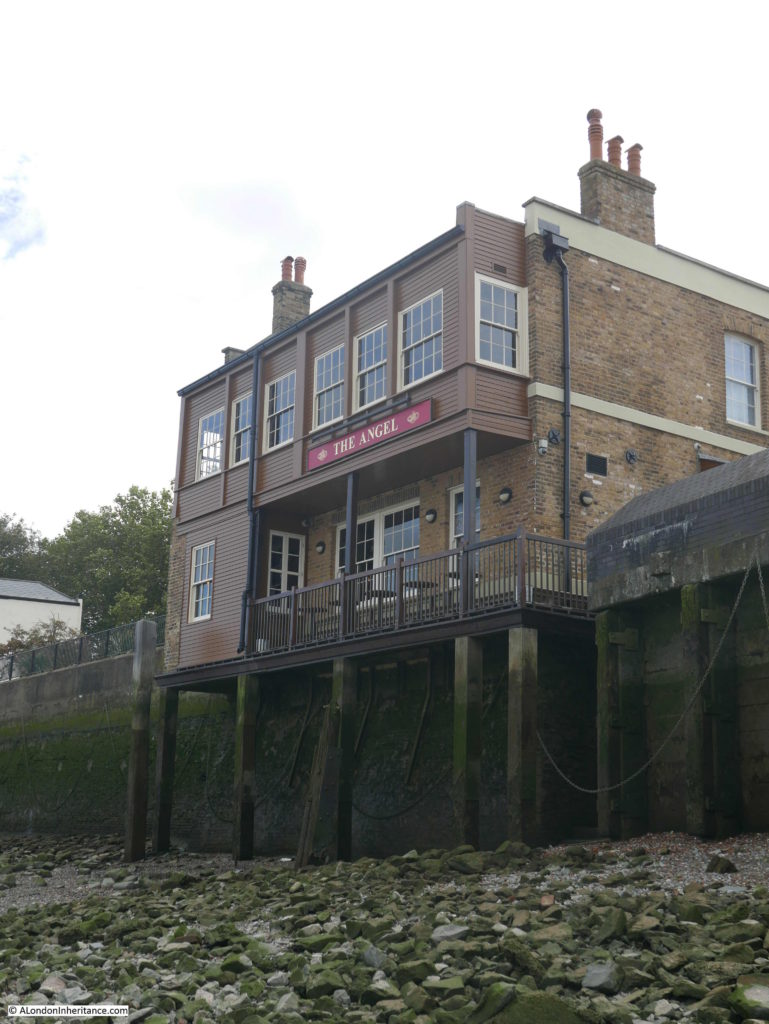
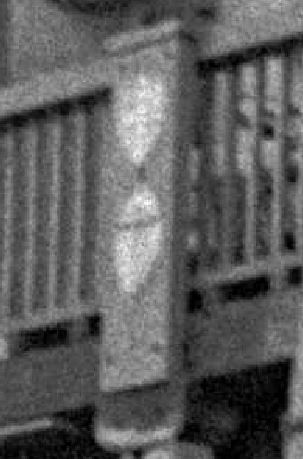

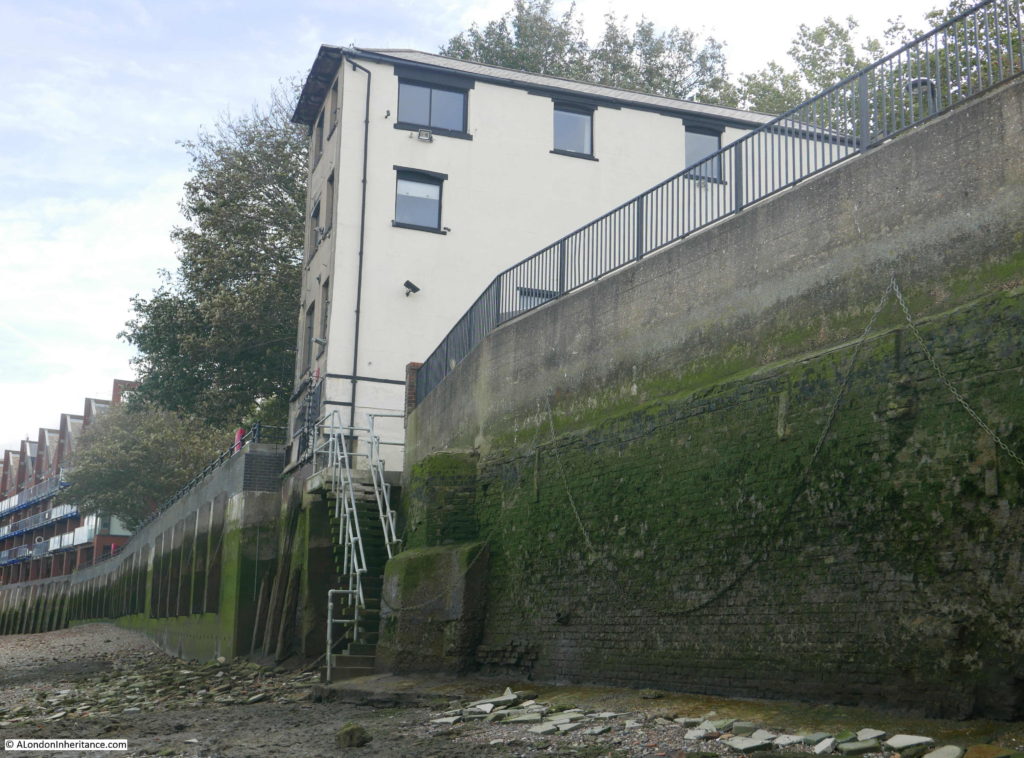
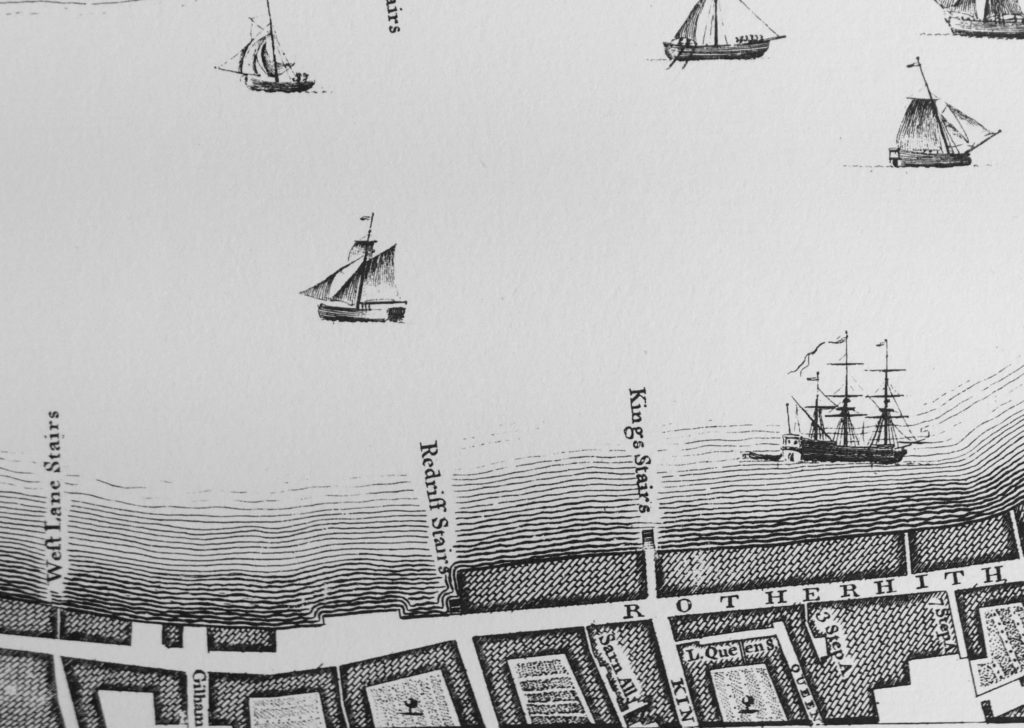
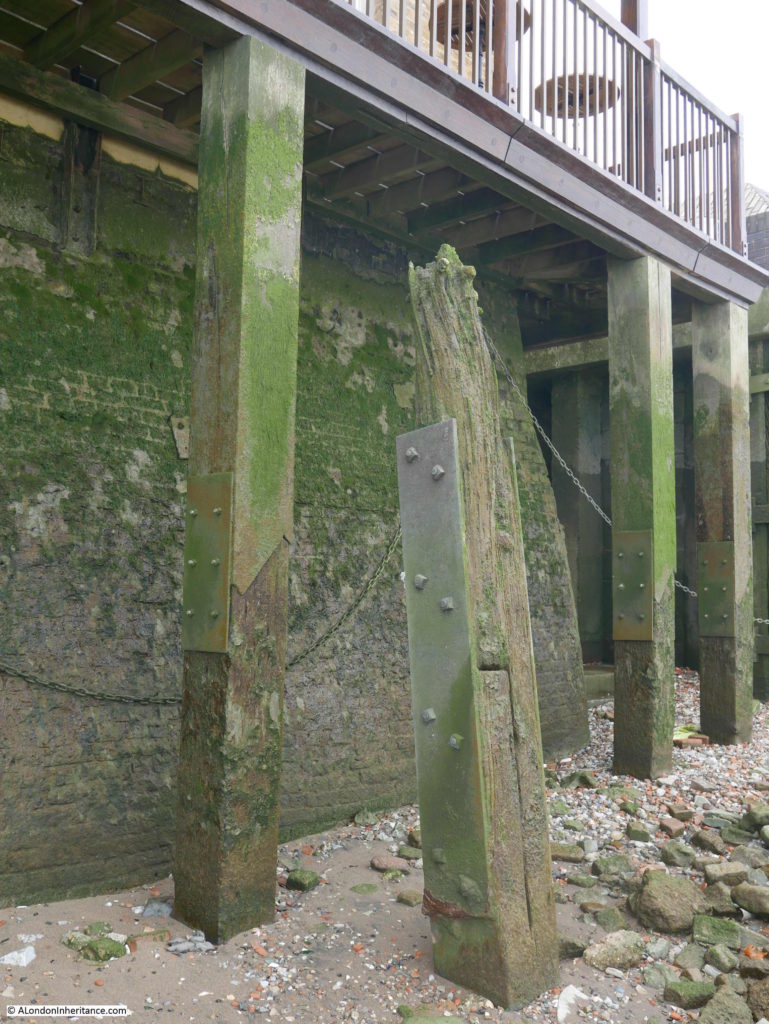


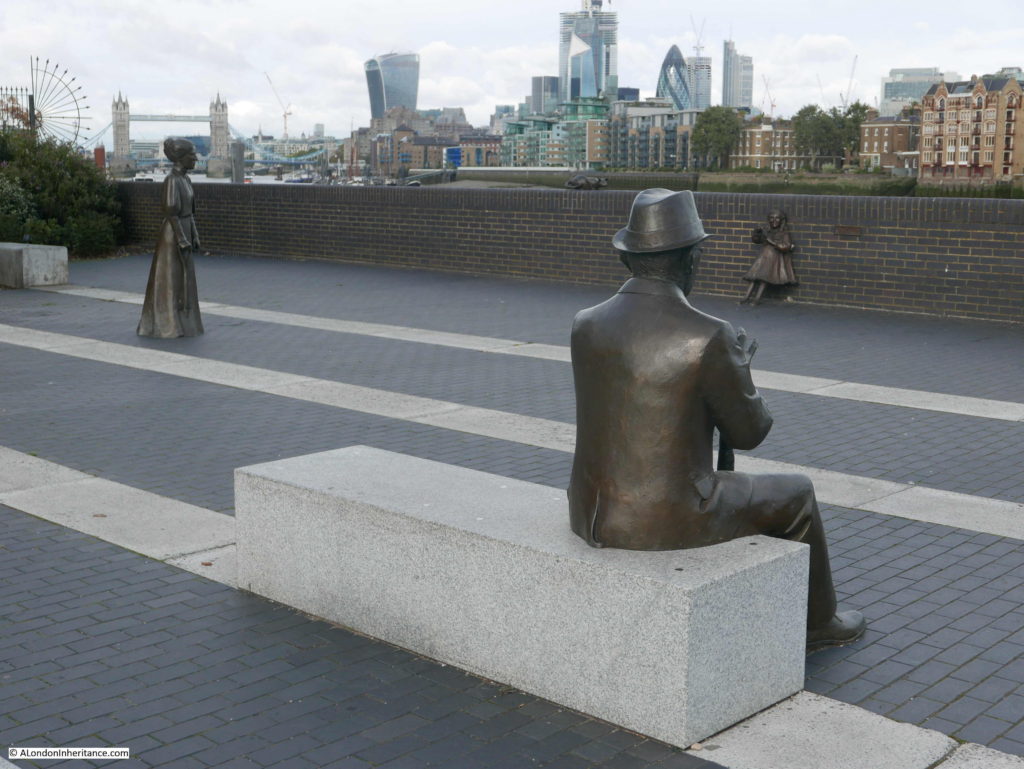
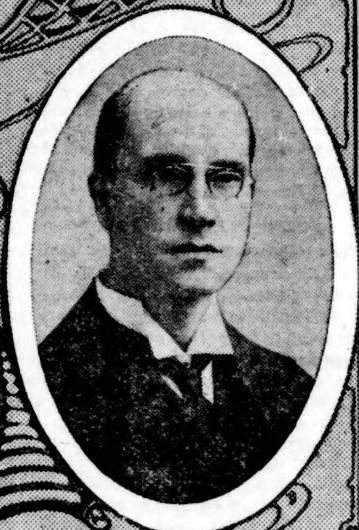
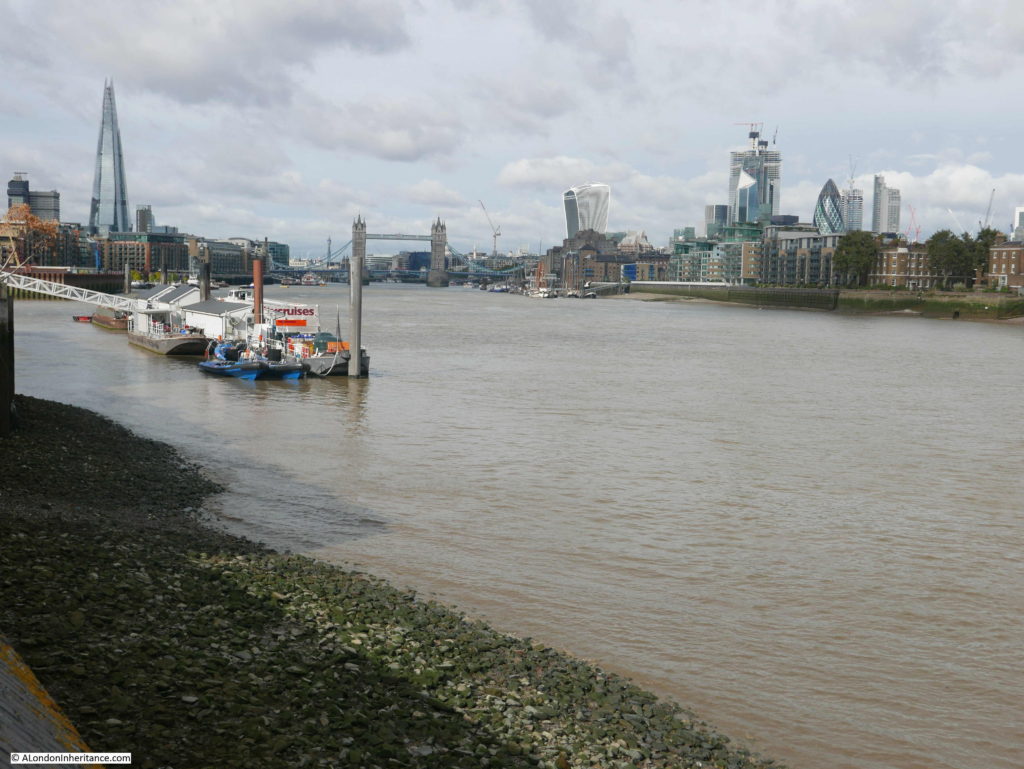
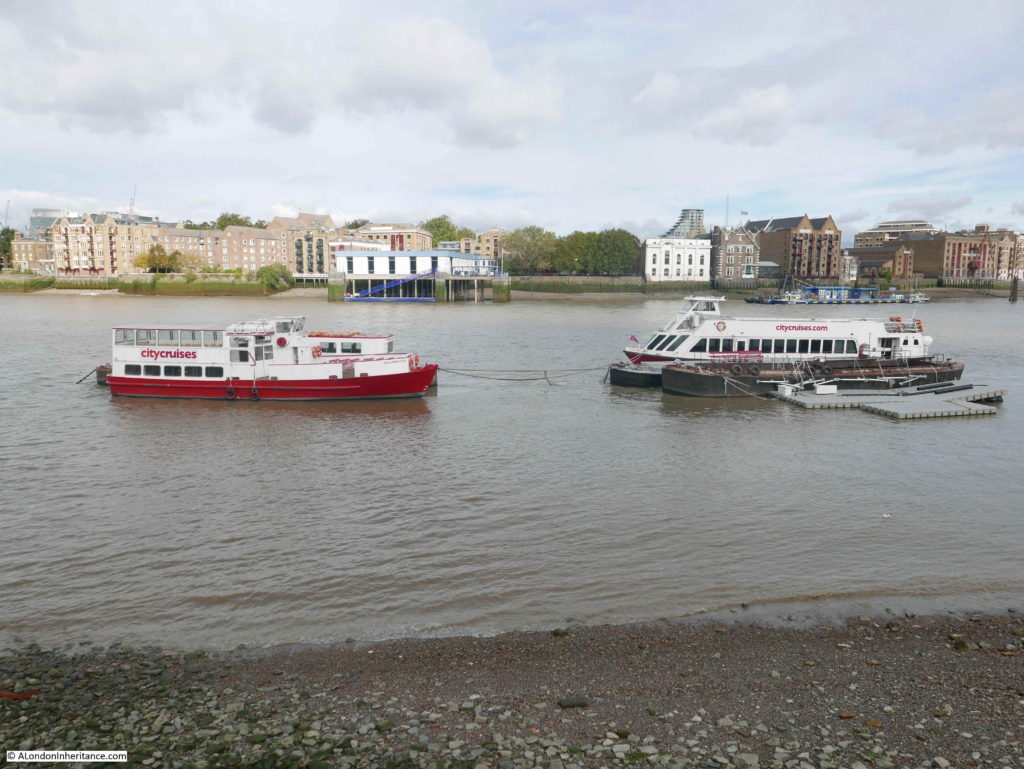
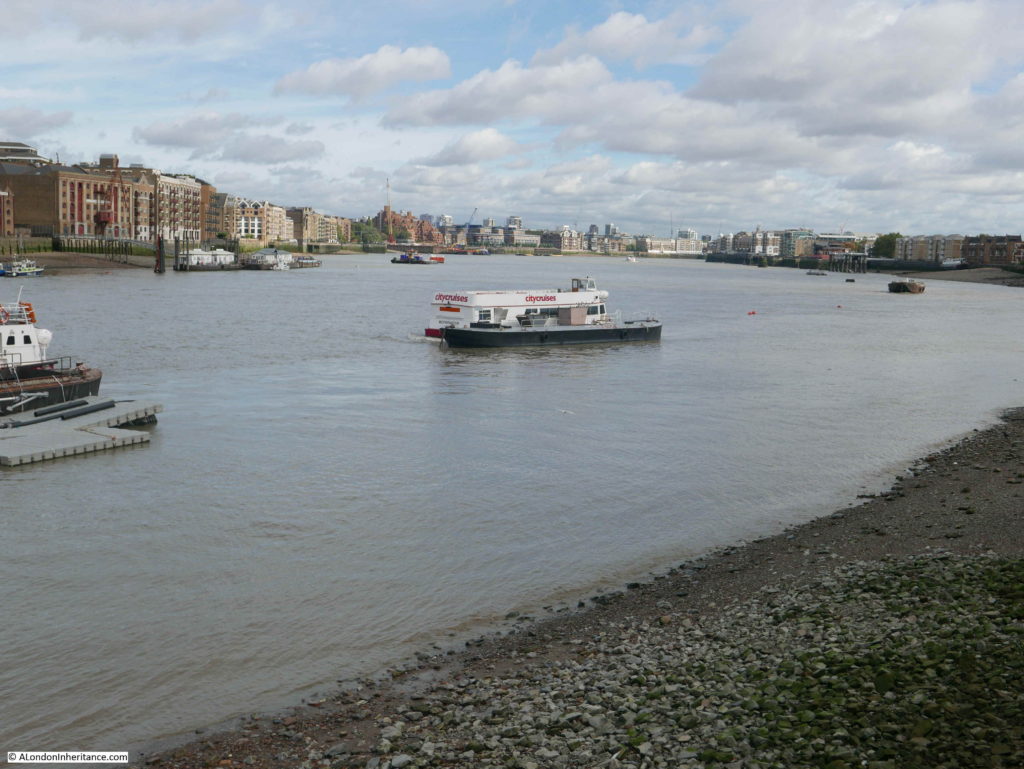

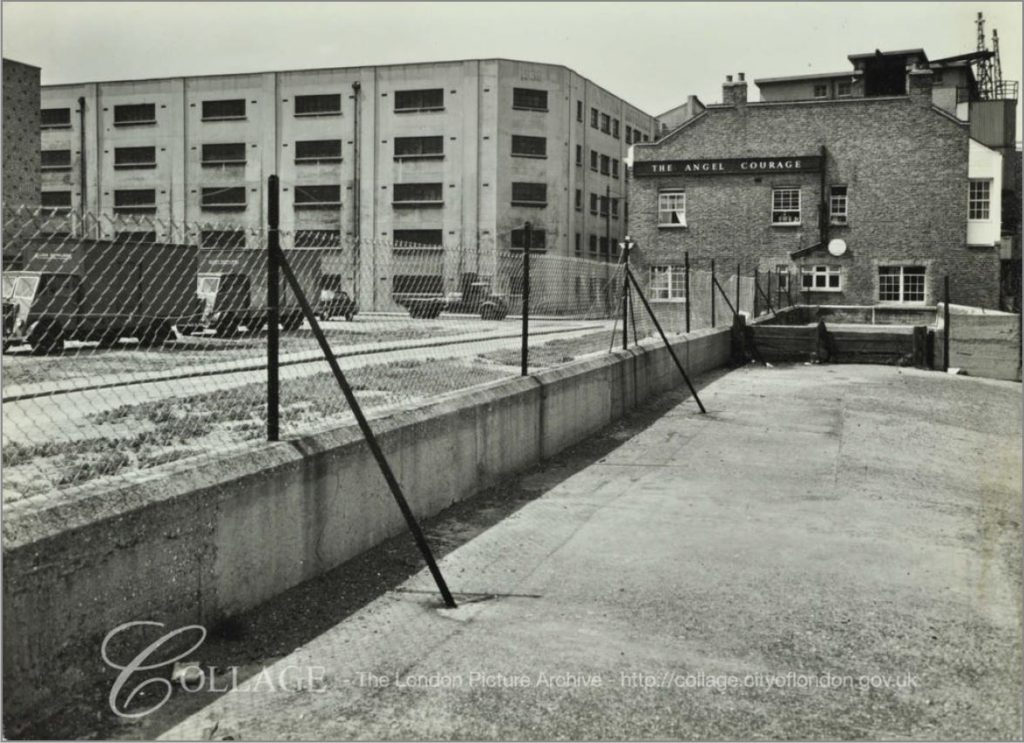
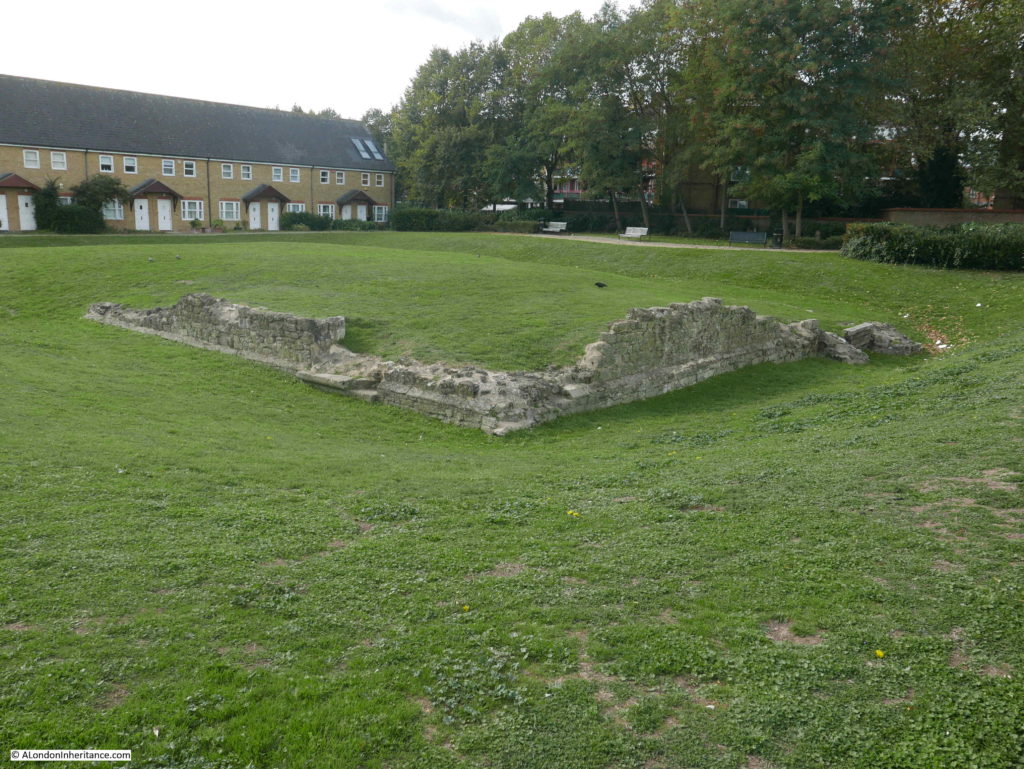


As ever, an interesting post, and one of an interesting part of the city.
I’m afraid it does look as though a lot of restoration has taken place on the outside of The Angel, perhaps not surprising given the exposed nature of the site. I do hope those doing the work have used materials sympathetic to the age of the building and its listed Grade II status…to my untrained eye the (now very neat) exterior cladding looks as though it might be made from plastic, instead of the former softwood shiplap.
A couple of years ago a friend of mine wrote what must be the definitive biography of the Quaker doctor (not Quack doctor!), Ada Salter (Ada Salter: Pioneer of Ethical Socialism). Well worth reading in order to get a better feel for the challenging social conditions of the area in the 1920s. But I think your figures on the local death rate must have gone a bit awry…even with the death rate reduced to 12.9%, this would have resulted in the entire population being wiped out within eight years! Maybe the figure is the child mortality rate?
I also have recently visited the Angel on the 1st September and rest assured the repaired weatherboarding is most certainly not plastic. Given the lisited status of the building, which you have noted, that would be impossible to achieve.
That’s good to hear. Thanks for letting me know.
@Jonathan The death rate figures are 16.7 and 12.9 per thousand, not percent.
Thanks for correcting this. If anything the figures now look a bit on the low side! The UK national death rate is still hovering around ten per 1,000, so Ada must have been phenomenally successful given that these were the days before antibiotics. (My initial thoughts were that your previous figures were child (under five). mortality rates, but I haven’t been able to double check this.)
Could the plaques be parish boundary markers? They are usually alongside each other, but sometimes above and below like this.
Great post about a lovely old boozer. The original statue of Dr Salter was stolen for scrap a few years back. Can’t help with the plaques but it might be worth while enquiring at Waterman’s Hall.
First class. Thank you.
Another superb article.
A look at Matt the Londoner’s excellent Flickriver picture of the pub shows that panel. By saving and cropping the image a clearer picture shows the badges.
Ref:
http://www.flickriver.com/photos/matt1965/sets/72157612547608665/
“…Local legend has it that Judge George Jeffreys (the “hanging judge”) used to come here to watch men die at Execution Dock, which was opposite, and that Captain Cook prepared for his journey for Australia here. During most of the 17th and 18th Centuries its busy riverside would have ensured a rich but not always salubrious variety of clientele, from river pirates, smugglers and thieves to sailors and press gangs. In the early 20th Century its reputation and location attracted local artists including Augustus John and James Abbott McNeil Whistler. In the 1940s and 50s it became a popular destination for celebrities. Today its customers are local residents, tourists and people walking the Thames Path…”
Ref:
http://russiadock.blogspot.com/2013/07/the-angel-public-house.html
From that, at least one of them appears to be an anchor.
Thank you. Yet another site to which to pay closer attention to on a future London walk.
Although you say the plaques on the post facing the river appear to have crosses on them, the upper one might be of the three lions, the Plantagenet coat of arms. Maybe this is connected with Edward lll having a Manor House nearby.
I think I am correct someone nicked the the statues relating to the Salter family for scrap value -have they been replaced? ,very interesting area .
Another interesting post, thank you
The statues of Alfred and Joyce were stolen some years ago from their original location on the promenade at Bermondsey Wall East, although the cat survived as probably having less scrap value. The thieves were never caught.
The new statues, now including Ada, were commissioned as the result of a local fund raising initiative.
The ‘posts’ are timber piles that would have been driven into the river bed and used to support the balconies. The upper portions of the piles would normally rot around and just above the high water mark, thus necessitating their replacement on a regular basis. The lower portions of such piles remain saturated and do not normally need to be replaced, hence new tops are fitted the lower portions of existing piles. The scarf joints look very neat but the steel plates and associated fixings look lightweight.
The raking piles would have been provided to keep craft away from the piles supporting the balconies. If these piles were damaged by a heavy contact the balconies would not have been damaged or collapse and anybody on them would have been safe.
The other building is the last remaining building from a closely packed terrace of similar buildings and has a pronounced lean, which it has had for many years. Up until around 30-40 years ago it was the offices for Brathwaite and Dean a (now presumably defunct) lighterage company.
A fabulous, fascinating post. Thankyou for helping to uncover the layers of history in this small area of London. This is the exact location I used for the climax of my novel Bourbon Creams and Tattered Creams. Nice to see the pilings in detail!
Born on the Dickens Estate. Bermondsey – We would collect all the discarded rare beer bottle tops from the foreshore under the Angel Pub. We would pin them to the side of our go cart made from a plank of wood, four pram wheels and an old Orange Box. The tops were from all over the world. Mainly Germany and Scandinavia. Good days.
Thanks for the interesting read!
I noticed here there’s a picture of the curious metal plaques and while the top appears to be a coat of arms, the bottom one looks diamond shaped.
http://russiadock.blogspot.com/2013/07/the-angel-public-house.html
That photo seems to come from Colleen here: https://pubshistory.com/LondonPubs/Rotherhithe/Angel.shtml.
Maybe it’s worth asking Pubshistory more about it. The print also may have come from Southwark’s local history library.
Do you have a negative of your father’s image? There will be more detail on the negative than in the scan. It might be worth looking at through an enlarger (though it will still be quite grainy).
I treasure your articles and save them . Many thanks to you and your father. I was born Rotherhithe, old Manor Lane, which no longer exists. My g’mother and mother each raised families of 6 children. Must have had good immune systems. No antibiotics! I wish my school had taught local history. An abbey and a Manor must have been there. Abbeyfield Rd ran along Southwark Park. I was evacuated in 1939 but still was in area a lot. Anderson shelter in garden, always wondered who put it there.
Again, thanks.
My G.G. Grandfather was landlord here (I am led to believe) in the early part of the 20th century, his name was John Taylor. Very little known of him, I’d love to know more – my G.G. Grandmother left him 2 years into their marriage and I gather his health took a turn for the worse. I have an old photograph we think is of him but can’t be sure. Can anyone help? I believe he lived Perseverance Street at some time in Rotherhithe.
Very interesting I lived in rotherhithe in park building paradise street I have been to the angle pub many times now I will look at this great British taven with fresh eyes
Very interesting , I lived.
in rotherhithe in park building paradise street I have been to the angle pub many times now I will look at this great British taven with fresh eyes
Many thanks
The American Artist James Whistler was lodging at The Angel in 1860 with his mistress Joanna Hiffernan.
He did several painting of the Thames from the balcony at the back. They Include,’ Wapping’, ‘Rotherhithe’, and’ The Thames in Ice’, apparently the winter of 1860 / 61 was a particularly hard one. I’ve only just discovered this site but find it very enjoyable.
My father gave me a pewter tankard engraved ‘P.F.Umney, The Angel, Rotherhithe, London, 29 October 1960’. Does anyone know if the date has any significance?
My father was born in Deptford in 1904 and lived till he was 18 in Bermondsy and Rotherhite. At that age he migrated to Australia under the auspices of a Horticulture Apprentice scheme established by the South Australian government. Reading about the Angel Hotel has me wondering about the place he told me stories about – how he and a couple of mates would sneak into a local pub at high tide and dive of the balcony between barges as they drifted apart on the tide. They would only get a two or three dives in before the local constabulary would be called and they were told to get home after a stern talking to.
Also I read with interest about the Salters and the fact that TB was rife. Dad’s father died in 1917 as a result of TB, leaving my father (13) and two sisters aged 15 and 19
I was there today, having a pint and a chicken burger under the lifebelt in your father’s photo. Another image shows the nearby ‘leaning tower of Rotherhithe’ which attracted my attention. The Angel’s landlord (?) said that it had recently been bought by a Russian oligarch (one not currently sanctioned?), and needed expensive underpinning work doing. I’m surprised that the remains of Edward III ‘s manor survived under the warehouse, nice that it is now a grassed area. Walked downstream along the Thames path, past the Mayflower pub, always heard that that ship sailed from Plymouth rather than began it’s voyage in Rotherhithe. Ended up in the Greenland Dock.